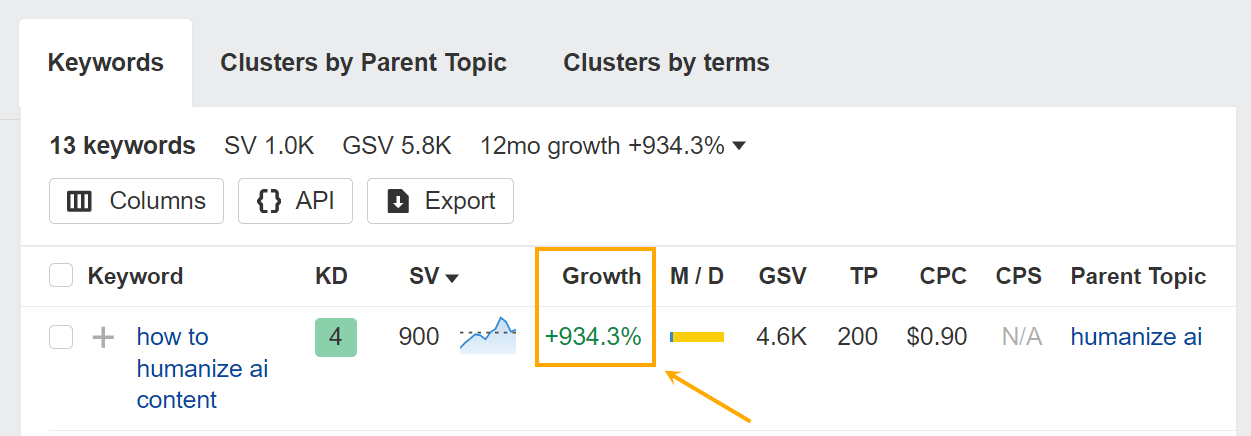
More people are trying to “pass the human check”, either to make AI content suck a little less or to blag AI content detection tools.
The process of “humanizing AI content” has become the de facto content strategy of growth-hungry companies.
I see stifled writers sprouting up everywhere, asking for advice on how best to navigate this content headache.
And I know just how soul-destroying it can be, because I’ve got the t-shirt.
Here’s why it’s a doomed effort from the start.
We all know the big glaring problems with AI content (and if you don’t, you can read about them here), but I don’t believe anthropomorphizing the bot is the solution.
In fact, I’d argue that humanizing the long-form content churned out by AI is an inherently flawed process.
The whole point of using AI is to drive speed, scale, and efficiency; getting humans to edit, and essentially rewrite, long-form AI prose completely undermines that value proposition.
By the time you’ve researched and added in the “rich” human element, you may as well have created the content from scratch yourself.
And the process of running “humanized” AI content through a detector is nonsensical – you’re literally getting an AI to validate humanity.
I’d spend hours editing the AI content I’d been saddled with so it could pass the human check, only to be gaslit into thinking my content was AI… by an AI?!
And I’m not the only victim. In a LinkedIn post, content consultant Kiran Shahid shared that AI detector tools would only verify her humanity when she wrote in first-person – a style of writing that clients are unlikely to sign off on.
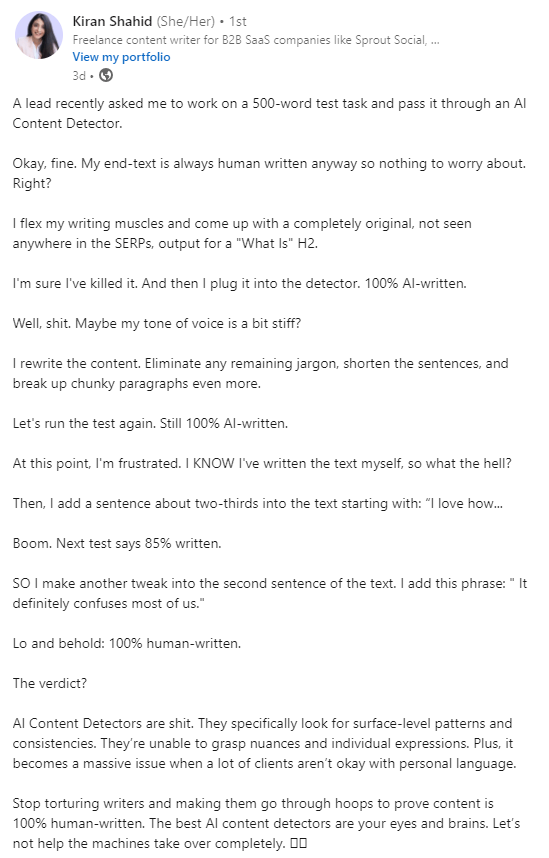
I have seen similar experiences being shared in the Women In Tech SEO community…
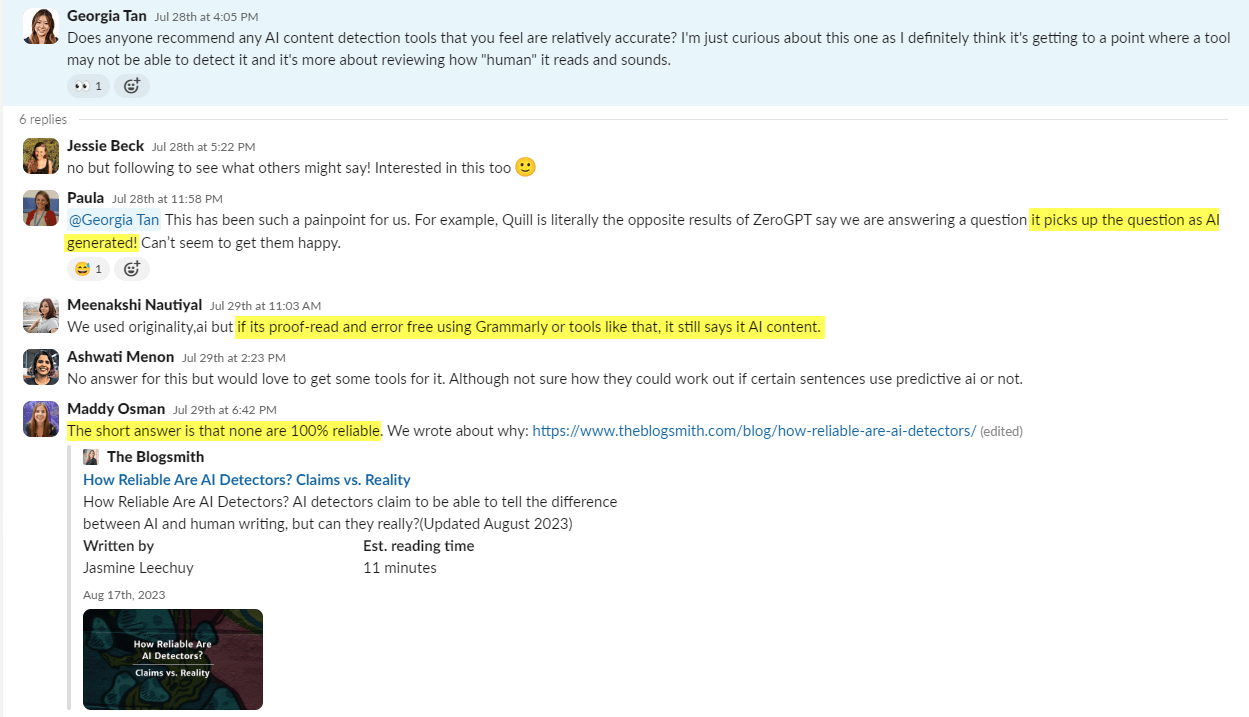
And on Reddit…
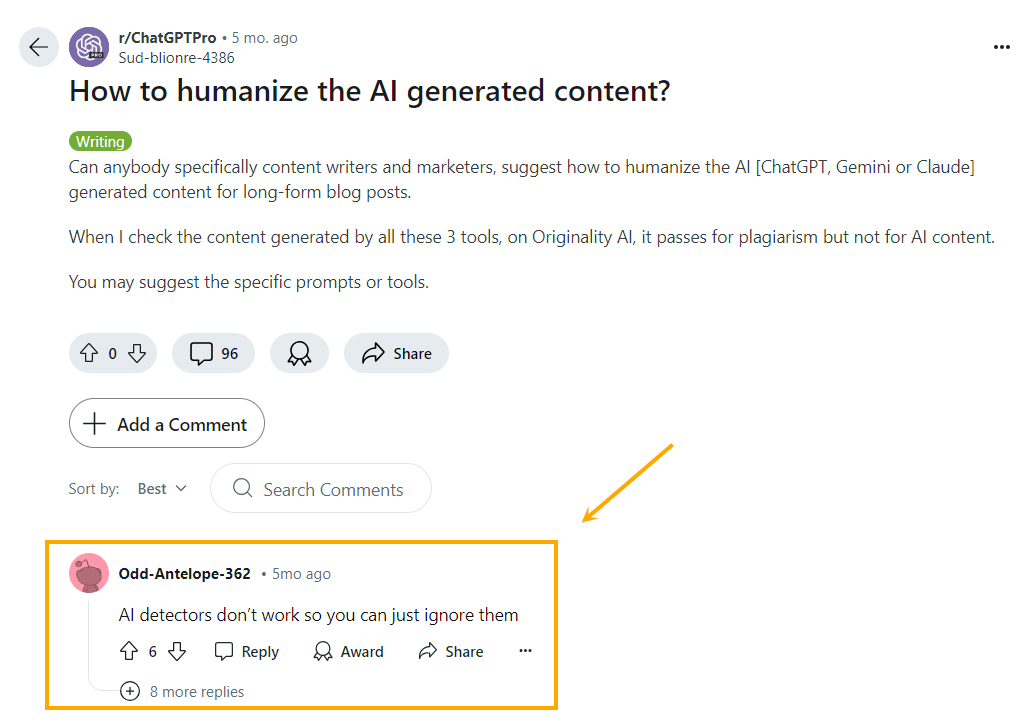
Having human writers gussy up AI-generated content, only to have AI evaluate their humanity, is not just bizarre — it’s a flagrant waste of talent.
When I was required to “humanize AI”, my workflow looked something like this:
- Receive batches of 100% AI content to edit
- Make sure each article was at least 50% “human” in AI detection tools
- Turn all the circles green in the SEO traffic light tool (pro tip: keyword stuff. Apparently it works wonders in 2024!)
The AI articles sent over to me were so off the mark I basically rewrote them (but with the added pressure of an unrealistic deadline) and, even then, the end results were subpar.
When you’re shoehorning in examples, opinions, and insights which could have shaped the article if only they had been included from the beginning, the content’s flow is inevitably going to be compromised.
At this point, I want to make something clear. I’m not anti AI. I use it every day for ideation, structure, outlines, and repurposing – my number one workflow is improving the pacing and readability of content I’ve written in “flow”. Used like this, AI can be incredibly efficient.
But the process of “humanizing AI” — where you start with 100% AI-generated content and animate it like you’re Mary Shelley breathing life into Frankenstein’s monster — is one of the most menial tasks and beyond demotivating for writers (despite how cool I’ve just made it sound).
If you’re the one enforcing this kind of strategy, you should also know that it is a great way to haemorrhage talent.
Humanizing AI content is unsustainable and inefficient, but some companies will make you do it anyway.
If you’re in this situation, one way you can make your life a little easier is by training AI on your content from the outset.
This means, whenever you’re handed a batch of AI generated articles to “humanize”, you can run them through your self-trained AI model and get them up to a more passable level of humanity, before going back in with your own edits and additions.
Training an AI model is a smart move because it improves the AI system itself; otherwise, it’s just laborious manual work, and you might as well have written the content to begin with.
Tools like Claude allow paid users to create shared “Projects” containing up to 200,000 words of training documentation, while ChatGPT’s customGPTs let you train on up to 20 files, each with a maximum size of 512 MB.
Nishkarsha Kotian, SEO Specialist at Channel Engine feeds examples of her brand guidelines to a customGPT, and sets out rules for the bot to follow.

Similarly, Melissa Popp, Content Strategy Director at RicketyRoo, trains her customGPTs on knowledge documentation, and adopts a process of “few shot prompting” by providing examples of her best content.

Given that AI tools have a “memory”, you can also practise “iterative refinement” while chatting with them.
In other words, you can train them bit by bit, using advice and examples to improve the overall content output. Digital PR Expert Gini Dietrich describes AIs as “digital interns” in this respect.
The thing is, training takes up a lot of time, and even with all the context in the world, if you don’t have a clear vision of what you want from your digital intern you can easily get trapped in endless prompt loops.
So, training an AI model can lighten the load a little, but it’s far from foolproof.
Melissa Popp notes that customGPTs only get her 40-50% of the way there, and the effort expended in training often undermines the benefits.
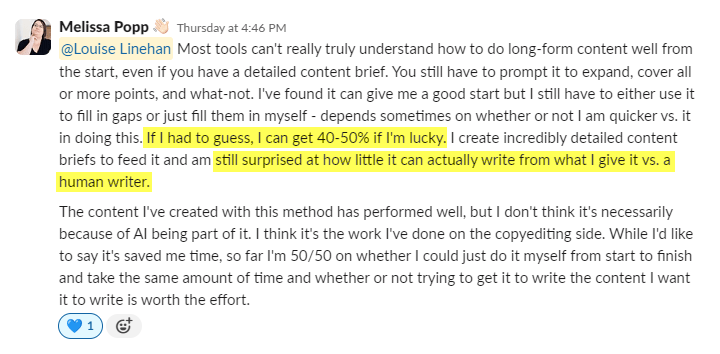
It can be tricky to question “efficiency” strategies like humanizing AI – especially if they’re dictated on high.
Those making the decisions often don’t understand the reality of the work, and are only concerned with turning spreadsheet numbers green.
But it’s your job to make that reality impossible to ignore.
In my case, I took these steps:
- Regularly fed back on issues I faced during the process of “humanization” in meetings
- Tracked the time I spent “humanizing” AI in a collaborative spreadsheet to prove time-sink
- Outlined the risks of pushing out subpar AI content with examples of brands that tanked in the SERPs due to manual or algorithmic penalties
One approach I didn’t look into, but you could try, is guiding stakeholders towards AI content that doesn’t need as much of a human touch, like:
- Glossaries
- Product descriptions
- FAQs
- Wikis
If the ultimate goal is traffic, you could also consider proposing non-AI initiatives that have been proven to drive traffic at scale.
In Ahrefs’ recent research on the 50 Bootstrapped SaaS Companies Dominating SEO in 2024, the brands driving the largest YoY traffic growth had embraced three core strategies:
- “free tools” creation
- programmatic content
- content localization
Non-AI projects don’t have to be time intensive either. Zapier, for example, created thousands of feature-based landing pages programmatically, and then outsourced the page copy to partners during onboarding.
This kind of traffic-play is far more likely to satisfy a client/higher-up’s need for quick-win growth, giving you time back to focus on your job of creating quality content.
Final thoughts
Humanizing AI generated content is unsustainable and – contrary to what many people think – inefficient.
AI should be used for ideating, planning, and drafting from the outset – not ghostwriting.
In the words of Moz’s Senior Content Marketing Manager, Chima Mmeje:
AI content is not the problem. The problem is when the content is so poorly written, I can tell it was AI-generated. AI detectors are trash. If you hire a writer and you’re passing content through a detector as proof that it’s engaging or authoritative, then you should not be working with writers. Writers, I’m begging you to stop using AI to create entire content. Please use it as a guide to help you flesh out ideas, complete a thought process, or even clean up your writing, but that first draft should be 100% your work.
If you’re reading this and you have the power to dictate strategy, do away with the soul-destroying process of humanizing AI content.
Trust your humans to write content for humans.




